You are currently browsing the tag archive for the ‘sculpting processes’ tag.
I finished a sculpture at Tynemouth Longsands beach yesterday by dipping it in the sea water. I’ve more images and this photographic series and they will be available as original photographic prints in the near future. Have a great week and come back soon for the next blog post. Cheers!
Dear friends. I’m tempted to show you my new sculpture, which is part of my ongoing exploration of sports balls as sculpting materials. However I’ll hold on to that yet, and share this image of my first ever opened golf ball, which turned out to be pink inside! If you would like to see my organic golf ball sculpture, please read on this invite:
You are warmly invited to our “Open Studio Weekend” and an exhibition “Aggregate” on Friday evening, Nov 4th, and Saturday Nov 5th, 12-5, at ASC Studios Unit 3, Bow E3 3LT. Apart from the general refreshments, I’ll be serving snacks, good atmosphere and lots of news. This will be a unique chance to buy directly from my studio, and all sales will go towards shipping of my art and possibly myself to “London Calling” show in LA, OCCCA over Christmas! I look forward to your visit! Cheers.
What a day it was on Wednesday! I managed to get in to Angela Marmont Centre for Bio Diversity, Natural History Museum, London, which is specialized research centre open to public and professionals, to search, study, identify and talk to experts about anything you can think of from Natural History. Not always booking recommended. I was in need of seeing Bombylius Major. I love the name, sounds like a soldier fly, but in fact it is a Bee-Fly. The name might be misleading. It is a fly, that pretends to be a bee! It’s behaviour is fascinating. It lays eggs in bee and wasp nests, it pollinates flowers with it’s elongated nose and it hates cold. It can wrap up it’s wings around to keep warm. So much more to tell, but instead, I present to you, my own photos of the specimen. Cheers and remember, not all that looks like a bee, is a bee! Don’t kill it.
Follow @silviakrupinska
S.Krupinska, Grape extraction sculpture, 22.4.2011 01
I became an art surgeon for the day. I was testing what happens when I cast some grapes in plaster. It was coming out easier than the previous materials I used. I didn’t expect to have so much fun excavating it from the setting. Watching it back makes me giggly for some reason. It is disgusting and organically beautiful at the same time.
 ””””””””””””””””””””””””””””””””””””””””””””””””””””””””””””””””””””””””””””””””””
””””””””””””””””””””””””””””””””””””””””””””””””””””””””””””””””””””””””””””””””””
///////////////////////////////////////////////
………………………………………………………..
………………………………………………………………………
As promised, I’d like to report back with a bit more detail, about the Hartberg Museum Exhibition- Recycled Art. The main reason, why the Symposium took place, was to make the conceptual art proposals for the coming Recycling Art Festival and to show the people in Hartberg and its surroundings, that recycling materials can be fun. The slogan “Trash-Chance-Idea” and all about the passing of time, were our guide lines. Each of the Artists and Designers approached the topic in a different way. We became a strong, lively group, getting on very well together. We were – Zara Alexandrova, Chris Gossington, Manuela Fritz, Erki Kasemets, Margit Klammer, Christian Kammerhofer, Hertha Wendelin Kovacs, Miss Lata, Iveta Laure, Evelyn Loschy, Wolfgang Luh, Baiba Osite, Pernilla Philip, Kiril Prashkov, Daniela Riedl, Liga Sakse, Dieter Serfas, Luca Zupelli and I, Silvia Krupinska. I need to mention and say thank you to Margit Nohrer and Manuela Fritz, who were the organisers. The journalists from Radio Hartberg made during the private view this short video and here are their photos.
I had a wonderful time in the city of Hartberg, which charmed me so much; I definitely want to go back in a couple years for the Recycling Art Festival. I miss the people and the food already!
Here is the fully recycled hero ‘Animal’ with its fully recycled ‘Food Tray’ and behind it, its ‘Poo Tray’ which is all, yes again, made from all-recycled materials found in local Ecopark. (All rights reserved.)
Please join us at our special event of art and design and so much more- Spit and Scrub. It’s our open studio weekend at the ASC Bow studios on Empson Street, E3 3LT on 17th, 18th & 19th September. Ideal opportunity to buy affordable art and meet us, the artists. We’re donating 10% from all sales to a local charity- Bromley By Bow Centre.
Why don’t you come for a chat to my studio(4)?
I’m looking forward to seeing you! Drop me a line or send me a text if you want my full attention, we can arrange the time. Or simply just turn up. Cheers x
More info on http://www.bbbc.org.uk/events.php/285/spitnscrub-open-studios
Do you know that feeling, when you sit in your studio, after washing the floor, arranging the wall of your art again, getting ready for an open weekend (more about that later), and just sitting in a chair listening to Radio 4 (yes, I know) and staring in the the ceiling, in pure bliss of being so lucky to have such a space for storing your art ?! The temple of my creation. And then, there it is. ‘My Altar’ 2010 was created. An installation, one of many, that I set up rearanging stuff.
I keep coming back to this picture of my gradmother, back in Slovakia. The power behind it is wordly for me. And I keep daydreaming.
 Hi there. I’ll start to write about my From the Bottom of the Sea sculpture no. 6, and I’ll take you around the journey of sculpting processes in it.
Hi there. I’ll start to write about my From the Bottom of the Sea sculpture no. 6, and I’ll take you around the journey of sculpting processes in it.
What is it made from? Outdoor plaster, oil paint, and in the making process I used also plasticine. First of all I decided to go for outdoor plaster because previous works I produced, in the same medium seemed to work well for me, and sculpting out of the outdoor plaster was enjoyable. It was strong and wasn’t chipping and it allowed me a certain kind of freedom of decision. Taking a step back, another reason why I wanted a strongest plaster, for it to last long time and make my life easier in transport, but a disadvantage of the denser plaster is, it is very heavy, which I realized in the process. As to when I used Alpha Plaster (Fine Casting Plaster), that left a whiter surface colour however, it was significantly more brittle.
I’ve made five other similar but much smaller plaster sculptures previously, I’ve given this series name: From the Bottom of the Sea.
How is it made? I hesitated about revealing this however, I think sharing processes and techniques is OK, and it gives a deeper insight into my thinking and where I’m getting. This information is only going to be published exclusively on my blog.
I have poured my plaster mix over hundreds of plasticine shapes, into a mould in a square shape measuring about 70×70 cm, to be honest it was an old unused stretched canvas. I isolated it before pouring and let it set overnight. When I returned next day, I struggled to lift it up to my desk. No, it wasn’t stuck in the frame just very heavy. I guess it was at least 20kg. Somehow, I managed to lift it from the floor of my studio to my large desk, where I continued working.
There were a few different stages in making, and the next one was trying to dig out all the shapes from the set plaster, achieving the gappy see-through effect. See the image on top, where some holes have been produced, some plasticine is still showing. The image on the right is showing the reverse side of the piece.
I continued to excavate till all the plasticine was out. After taking a few steps back, looking at the shape and the texture, I needed to make it look neater and shape it so it felt right. I used a power tool to sand down the circles, and I made a decision to cut off the edges with a hand saw, and round it all up into a circle. See the both sides on the photographs with my sculpture rounded.
Organic feeling of the piece and something that looked like it could have been shaped by the water were some of my criteria. I continued on to sculpt the larger organic looking holes and digging into them to multiply the number of them. It was a long process and a lot of hard work. The plaster at that point was already stone hard, and all my tools are looking over-used.
All about the shape. Yes, back to the shapes. In the past, I liked to use as a ‘holding’ shape of a piece circle or square. As I looked at the unfinished sculpture, it being a circle still didn’t work for me, because it felt too real, tight and not natural for what I imagined could have come from the bottom of my imaginary sea. With a little hesitation, whether I’m going to break it in half, or ruin it completely, I made a drastic decision to shape it with a chisel-like tool and a saw to make it less regular with some broken edges, as they have been hitting rocks and sea bottom for some time. Despite it being probably most exciting moment after lifting it from the mould, gosh it was scary too! But aside all that drama, it quite fullfilled what I was aiming for and the final shape was born!
Colour next. As far as I was concerned, I wasn’t entirely happy with the sculpture yet. I would sit at home with my laptop, download all images from my camera, which I take each day and I would stare at them.”Think, think, think!” Next day in my studio, I made a decision to go for it, and make a painting of what I felt like it could have been some sort of old floating plants, either attached to my artwork or flowing near it in the water. There, was the sea-weedy colour overtaking the surface of my sculpture, and drops would suggest the direction, where the colour drips and splashes. The sculpture was finished!







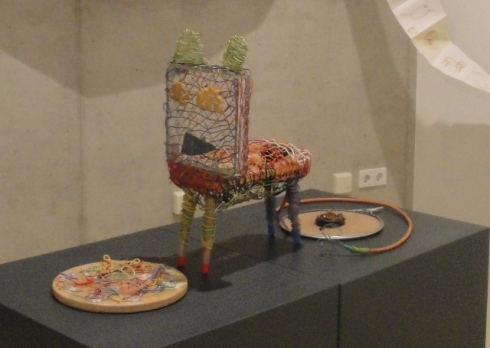
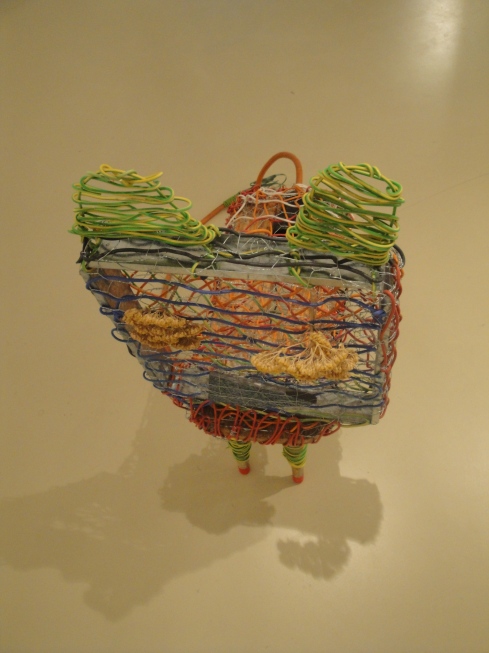
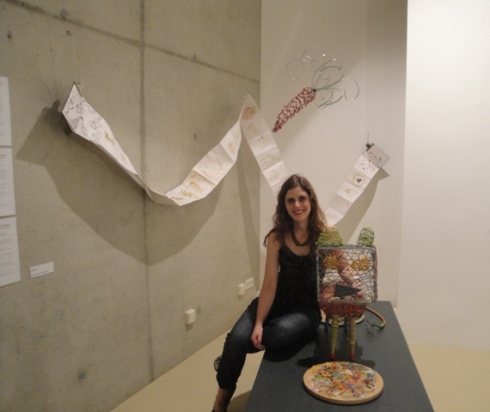
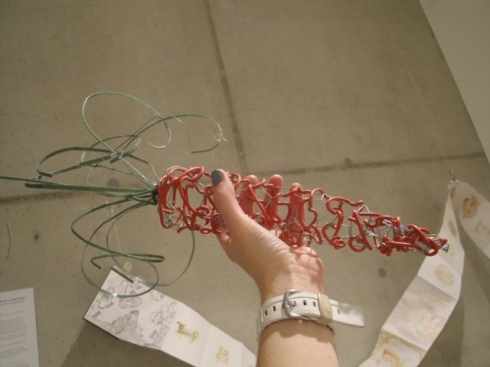
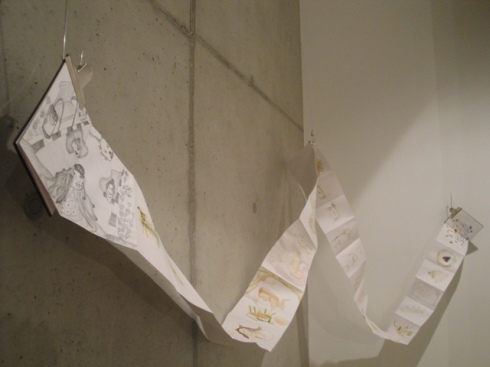
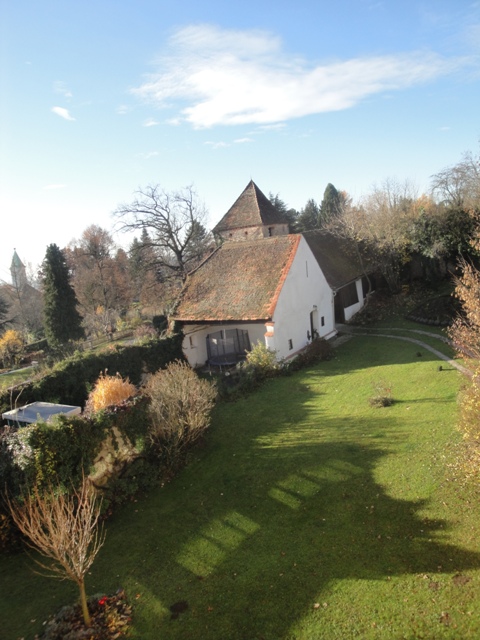
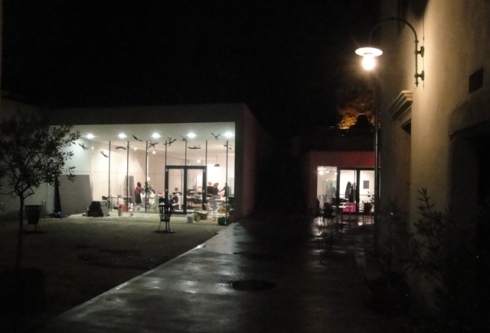








Video invitation to Organicities by Silvia Krupinska, Exhibition Charity Event.
September 24, 2011 in Exhibitions, Slovakian Artist, Work out of studio | Tags: art diary, art discussion and comments, charity event, Debut Contemporary, exhibition, nature in art, Organic Sculpture, Organicities, Organicities by Silvia Krupinska, sculpting processes, Silvia Krupinska, Silvia Krupinska Slovakian Artists in London | Leave a comment
Rate this:
Share this: